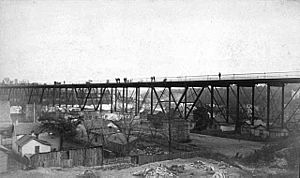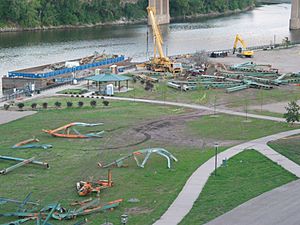Bohemian Flats facts for kids
Quick facts for kids Bohemian Flats |
|
|---|---|

Bohemian Flats, 2005
|
|
| Type | Urban park |
| Location | Minneapolis, Minnesota, United States |
| Status | Open all year |
| Website | Bohemian Flats |
Bohemian Flats is a cool park in Minneapolis, Minnesota. You can find it on the west bank of the Mississippi River. It's right below the Washington Avenue Bridge. It's also very close to the University of Minnesota campus.
Long ago, this area was called Little Bohemia. It was a shanty town, which means people built simple, makeshift homes there. This was around 1867, when Minneapolis became a city. Many European immigrants came here looking for jobs. They worked in the city or at the mills near St. Anthony Falls. Today, those old homes and buildings are gone. The park is now managed by the Minneapolis Park and Recreation Board. It's part of the Mississippi Gorge Regional Park. It's also inside the Mississippi National River Recreation Area.
Contents
A Look Back: The History of Bohemian Flats
Who Lived There? Immigrant Stories
The area got its name "Bohemian Flats" because many people came from Central Europe. Most families were Slovaks, Swedes, Czechs (Bohemians), and Germans. The 1900 census showed who lived there. Even though it was called "Bohemian Flats," most people were actually Slovaks.
Here's a quick look at where people came from:
| Origin | North of Bridge | South of Bridge |
|---|---|---|
| Slovaks | 613 | 22 |
| Swedes | 123 | 85 |
| Czech | 90 | 105 |
| Irish | 41 | 8 |
| Norwegian | 27 | 2 |
| German | 5 | 23 |
Because so many different groups lived there, Bohemian Flats had other names too. It was once called "The Danish Flats." Later, people called it Little Bohemia, Connemara Patch, Little Ireland, Little Lithuania, and Cabbage Patch. In the spring, when the river flooded, it was even called Little Venice! With so many nationalities, many small communities formed within the Flats.

Many residents worked at the Heinrich Brewery or the Noerenberg Brewery. Others found jobs in the sawmills and flour mills nearby. Railroad bridges and the first Washington Avenue bridge crossed over the Flats. Some houses were even directly beneath them. The people living there helped start churches in other parts of Minneapolis. They also traveled to the city center for their jobs. Many likely took classes to learn English and about American life.
The population of the Flats grew to over 1,000 people at its busiest time. Living on the Flats was good for immigrants. It was close to their jobs at the mills and breweries. It was also very affordable. Residents could even collect lumber that fell into the river. They used it to build their homes or sold it for extra money.
Living with the River: Spring Floods
The homes on the Flats were simple shanties. They often didn't have strong foundations. The Mississippi River was known to flood every spring. This was a big problem because the Flats were not much higher than the river. Each spring, the water would rise and flood the area. Sometimes, the poorly built houses would be washed away.
When floods happened, people had to pack their things. They would stay with friends or family temporarily. There were even stories of people camping in the empty Noerenberg Brewery until the water went down. The river would also carry away belongings like sheds and woodpiles. After the water went down, chickens were sometimes found drowned. A very big flood happened in April 1952. It forced everyone in the Upper Levee and parts of the West Side Flats to leave their homes.
How the Area Changed Over Time
The Flats had three main parts: the upper flats, and the north and south lower flats. Homes on the upper flats were popular. They were in high demand because they didn't get flooded in the spring. A cliff separated the upper and lower flats. Rent for upper flats was about $15–20 a year. Lower flats were much cheaper, from $.50–2.00. To reach the lower flats, people had to go down 79 stairs! The upper flats also had more space. By 1885, the west side flats were full of small, wooden homes. By 1892, formal streets appeared. They were named Wood, Cooper, and Mill, which showed what many residents did for work.
The City Dump Problem
In 1890, the city was told to stop dumping garbage into the Mississippi River. So, the city found a new place: the banks of the Mississippi, right at the Flats! This dump was very unhealthy for the people living there. It was even called "Life at the Dump" in a newspaper article. In 1899, the State Board of Health ordered the city to find a new dump location. The article also mentioned that people were dumping other waste under the bridge.

Over time, the city needed the land for other projects. In 1915, some residents were told to leave. This was because a new lock and dam were being built. In 1931, the city made people leave the northern part of Bohemian Flats. They built a coal barge facility there. Later, a brick building for shipping goods and a railroad yard were added. A grain loading facility was also built. The city used a process called eminent domain. This means the government can buy private land for public use, even if the owner doesn't want to sell.
The very last resident of the Flats stayed until 1963. This was when the current Washington Avenue Bridge was built. His name was Joseph A. Kieferle, and he was 80 years old. He had lived on the Flats for fifty years! One abandoned house remained until the late 1960s. In the 1940s, a large brick building was built for single men working at the mills. Soon, families moved in, and it became a community center.
Recent Events
On August 1, 2007, the I-35W Bridge collapsed. This was a very sad event, killing 13 people. Much of the bridge's broken pieces were stored at Bohemian Flats for a while. This helped with the investigation into why it collapsed. The area was also used for construction work in 2015–2016. This was when the nearby Franklin Bridge was being fixed up.
Bohemian Flats Park Today
Bohemian Flats is now a public park in Minneapolis. It's part of the Mississippi Gorge Regional Park. This park is managed by the Minneapolis Park and Recreation Board. At Bohemian Flats, you can enjoy many things! There's a biking path, a garden, and picnic areas. You can also take river cruises or private boat charters. Restrooms are available too. It's a great place to enjoy the river and learn about history.
Bohemian Day Celebration
Bohemian Day is a special event held on August 20. It was started by artists and a woman named Gera Pobuda. This day celebrates the traditions and the immigrants who lived in Bohemian Flats. These immigrants came from places like the Czech Republic, Slovakia, Germany, Scandinavia, Ireland, and Italy.
The Lipa Slovak Dancers often perform on Bohemian Day. They wear beautiful traditional costumes. These costumes are all made by a woman from Slovakia. The Lipa Slovak group is named after the linden tree. This tree is the national tree of Slovakia. The dancers perform several times a year at different events. These include Czech festivals and the Festival of Nations.

